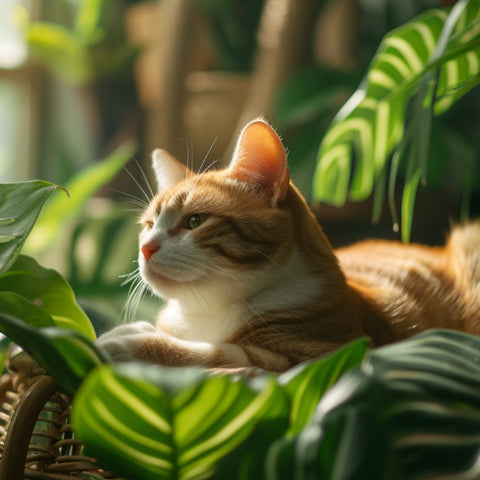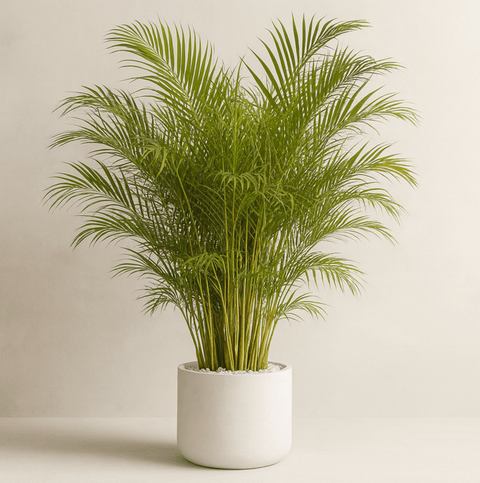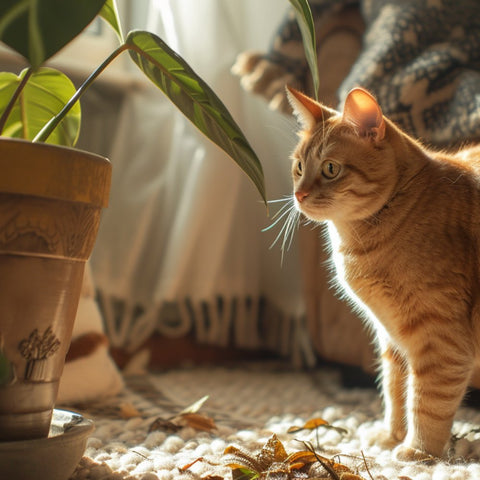Blog Post - What plants are safe for cats

Welcome to our guide on creating a cat-friendly environment at home! It's important to create a space where our beloved feline friends can thrive and stay safe. In this article, we'll explore the importance of incorporating safe plants into your home, as well as provide a comprehensive list of plants that are toxic to cats and alternative options that are safe and beneficial. Let's dive in!
The Potential Dangers of Certain Plants for Cats
Before we delve into safe plant options, it's crucial to understand the potential risks associated with certain plants. Many common household plants can be toxic to cats and pose a threat to their health. Lilies, aloe vera, and snake plants are just a few examples of plants that should be avoided. Ingesting these plants can lead to symptoms such as gastrointestinal issues, vomiting, and even organ failure.
Common Toxic Plants to Avoid
Here is a comprehensive list of plants that are harmful to cats:



Ingestion of these toxic plants can result in various symptoms and risks for cats. It's important to be aware of the potential dangers and take steps to keep these plants out of reach of your furry friends.
The Benefits of Cat-Friendly Plants
Now that we understand the potential dangers, let's shift our focus to the benefits of incorporating cat-friendly plants into your home. Not only do these plants enhance the aesthetic appeal of your living space, but they also contribute to the overall well-being of both cats and their owners.
Improving Air Quality and Reducing Toxins
Indoor air quality is a crucial factor in maintaining a healthy environment for cats. Cat-friendly plants, such as spider plants, Boston ferns, and areca palms, can help improve air quality by filtering out toxins and releasing oxygen. This not only benefits your feline friend but also promotes a healthier air environment for everyone in the household.
Enhancing a Cat's Mental and Physical Well-Being

Cat-friendly plants provide mental and physical stimulation for cats. Plants like catnip, catmint, and valerian are known to have a calming effect on cats, reducing stress and anxiety. Additionally, cat-safe herbs like thyme, parsley, and wheatgrass can provide cats with a natural source of enrichment and play.
Creating a Stimulating and Safe Environment
Incorporating safe plants into your cat-friendly environment creates a stimulating and enjoyable space for your feline friend. Cats are natural climbers, so consider adding vertical garden structures or hanging plants. This not only saves space but also encourages them to engage in their natural behaviors while keeping them safe and away from toxic plants.
Safe Plants for Cats
Now that you have a better understanding of the benefits of cat-friendly plants, let's explore a list of safe plant options that are non-toxic and perfectly suitable for your furry companion:
List of Safe Plants for Cats
- Catnip, catmint, and valerian

- Spider plants, Boston ferns, and areca palms

- Cat-safe herbs like thyme, parsley, and wheatgrass

- Alternatives to toxic plants for indoor and outdoor gardening
These plants not only provide a safe environment for your cat but also add beauty and freshness to your home.
Tips for Incorporating Safe Plants into a Cat-Friendly Environment
Now that you have a list of safe plant options, it's important to consider a few tips to ensure a harmonious coexistence between your furry friend and your plants:
Selecting the Right Location for Plants
Place your cat-friendly plants in areas where your cat has limited access or doesn't show much interest. High shelves, window ledges, or hanging planters are great options.
Preventing Cats from Interacting with Plants
To protect both your plants and your cat, ensure that you take steps to discourage digging, chewing, or knocking over plants. Use deterrents like citrus sprays or aluminum foil to discourage unwanted behavior.
Picking the Appropriate Planters and Soil
Choose planters that are sturdy and stable to prevent tipping. Consider using heavy pots or adding rocks to the bottom of lighter containers. Additionally, avoid using toxic fertilizers or soil additives to protect your cat's health.
Establishing a Vertical Garden or Hanging Plants
If space is a concern, consider setting up a vertical garden or adding hanging plants. This way, you can maximize your space while still providing a safe and stimulating environment for your cat.
Regularly Monitoring and Maintaining Plants
Keep a close eye on your plants for any signs of distress or damage. Regularly prune and maintain them to ensure they remain safe and healthy for your cat.
Additional Cat-Friendly Ideas and Precautions
Here are a few additional ideas and precautions to consider when creating a cat-friendly environment:
DIY Cat Grass or Herbal Gardens
Growing cat grass or cat-safe herbs indoors can provide a natural enrichment activity for your cat. It's a great way to engage their senses and encourage healthy behaviors.
Avoiding Pesticides and Chemical Fertilizers
It's essential to keep your plants chemical-free. Avoid using pesticides or chemical fertilizers that may be toxic to your cat. Opt for organic options or explore natural alternatives.
Caution with Floral Arrangements and Cut Flowers
Be cautious when bringing home floral arrangements or cut flowers. Some common flowers, like lilies, can be toxic to cats. Ensure that any floral arrangements or cut flowers are kept out of reach of your cat to prevent accidental ingestion.
Conclusion
Creating a cat-friendly home is a responsible and rewarding choice for pet owners. By incorporating safe plants into your living space, you are enhancing your cat's well-being and providing mental and physical stimulation. Remember to avoid toxic plants and opt for cat-friendly alternatives that promote a harmonious and healthy environment. Let's create a space where cats can thrive and enjoy a safe, happy life!






























Comments (0)
There are no comments for this article. Be the first one to leave a message!